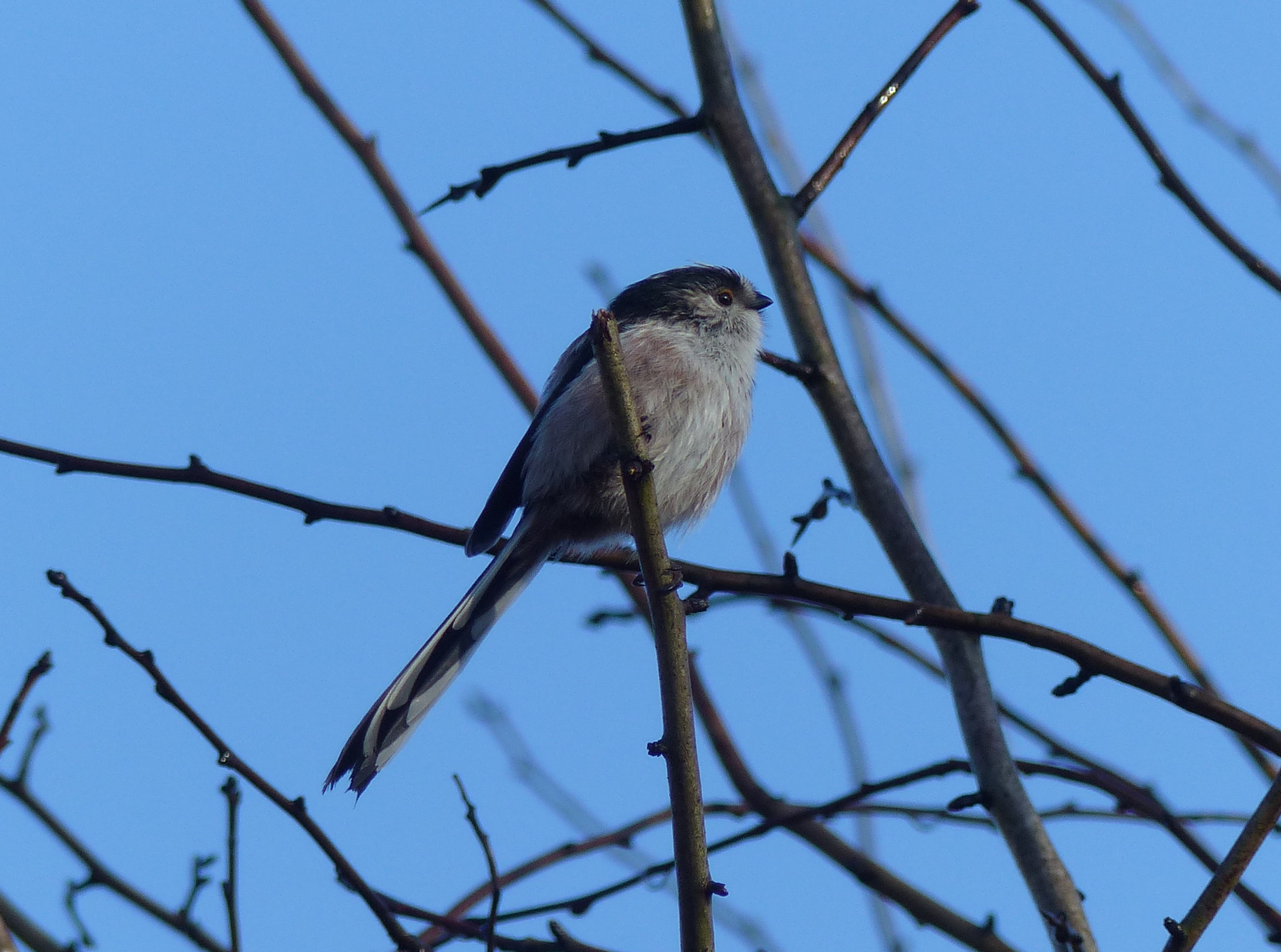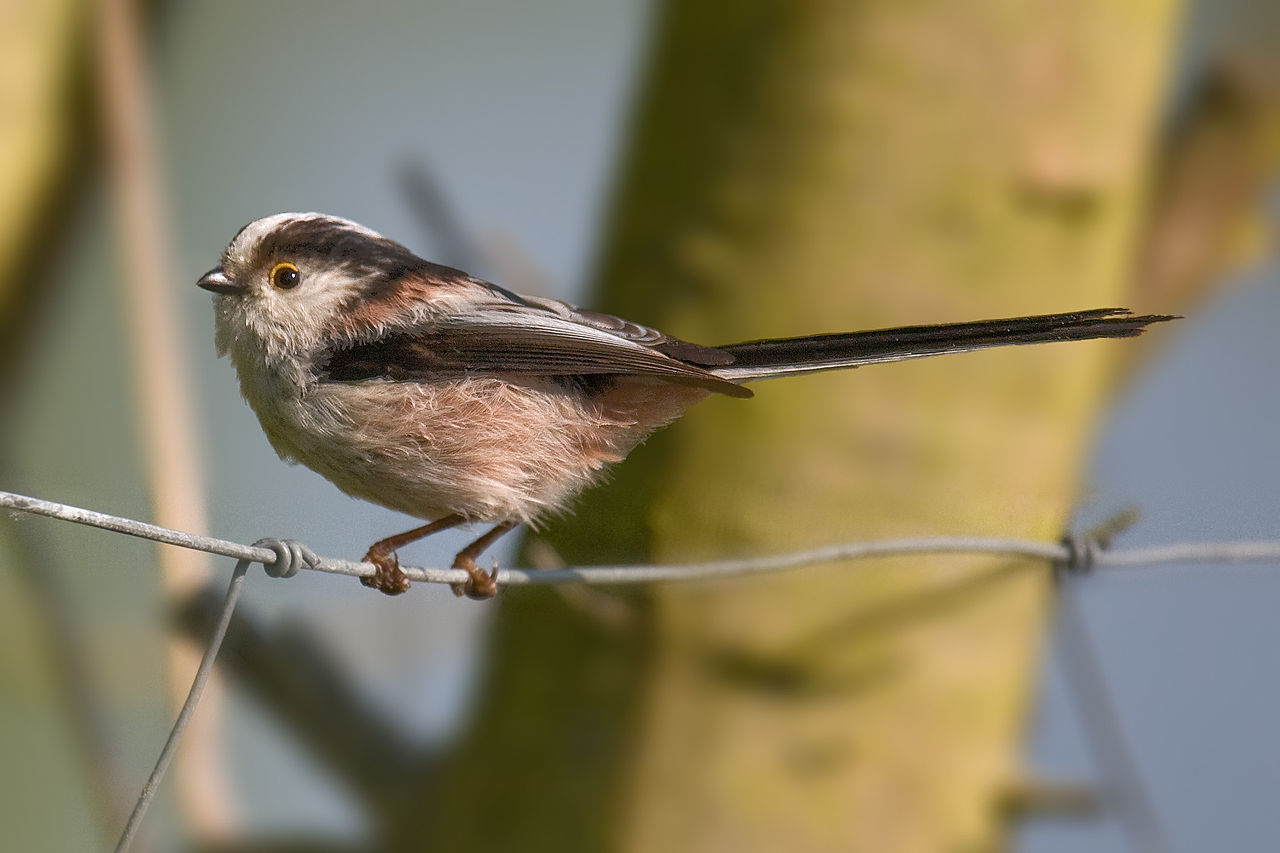Garden Wildlife
Garden Wildlife


Long-tailed tit Aegithalos caudatus
These are engaging tiny birds that visit gardens in flocks in the winter. If you see a bird that looks like a table tennis ball with a long tail flitting through your shrubs then it will be a long-tailed tit.
What do they look like?
These are among the smallest of garden birds seen regularly. Although the total length (14cm) is like the Robin, half of this is tail! They are restless birds, but if stay in one place for a few moments you can see they are quite colourful. The head has a white face, crown and nape, with a broad black streak starting above the eye and sweeping back onto the shoulders and back. The shoulders also have a broad pinkish band. The throat and upper breast are white but as you look further along the underside you see a rosy tint on the flanks, belly and ventral regions. The long tail is basically black but has white edges. The black bill is tiny but pointed and the legs are black too. The black eye has a narrow red ring around it. On cold days they are often seen sitting with feathers puffed up so they look almost spherical. See our tits page to compare with other species.
What do they sound like?
Mostly you will hear contact-calls as the flock of long-tailed tits moves restlessly through your garden, or flies overhead. This is a short buzzing sound, quite distinctive. The first you may know about these birds in your garden is hearing the call.
What do they eat?
Long Tailed Tits are insectivorous, eating tiny creatures and eggs from nooks and crannies in twigs, stems, leaves and buds. They are increasingly taking food from feeders in winter, such as fat, crumbled cheese and small seeds, birds in a flock learning by watching the activity of other birds.
What do they do?
These birds are classic winter visitors to gardens, when they will form flocks of 8-20 of their own species or join other groups of small foraging birds moving systematically through the gardens. Their call is a good indicator to start paying attention as a mixed flock approaches. They are restless, active birds, as acrobatic as the ‘true’ tits.
They build elaborate spherical nests of moss, spiderweb and down in shrubs. There is strong evidence that a pair will be helped in feeding the brood by siblings that have failed to breed and that this helps fledglings to survive. Broods can be large, often more than a dozen.
How are they doing?
The long tailed tit is found through Britain and Ireland and has increased in numbers over the past few decades, as shown in the BTO Breeding Birds Survey 2019, which reports a 20% increase over the last 20 years. There are thought to be at least 380,000 territories in England.
Finding out more:
Page written by Roy Smith, compiled by Steve Head


Irish Wildlife Sounds, XC692824. Accessible at www.xeno-canto.org/692824
Long-tailed tit Aegithalos caudatus
These are engaging tiny birds that visit gardens in flocks in the winter. If you see a bird that looks like a table tennis ball with a long tail flitting through your shrubs then it will be a long-tailed tit.


What do they look like?
These are among the smallest of garden birds seen regularly. Although the total length (14cm) is like the Robin, half of this is tail! They are restless birds, but if stay in one place for a few moments you can see they are quite colourful. The head has a white face, crown and nape, with a broad black streak starting above the eye and sweeping back onto the shoulders and back. The shoulders also have a broad pinkish band. The throat and upper breast are white but as you look further along the underside you see a rosy tint on the flanks, belly and ventral regions. The long tail is basically black but has white edges. The black bill is tiny but pointed and the legs are black too. The black eye has a narrow red ring around it. On cold days they are often seen sitting with feathers puffed up so they look almost spherical. See our tits page to compare with other species.
What do they sound like?
Mostly you will hear contact-calls as the flock of long-tailed tits moves restlessly through your garden, or flies overhead. This is a short buzzing sound, quite distinctive. The first you may know about these birds in your garden is hearing the call.
What do they eat?
Long Tailed Tits are insectivorous, eating tiny creatures and eggs from nooks and crannies in twigs, stems, leaves and buds. They are increasingly taking food from feeders in winter, such as fat, crumbled cheese and small seeds, birds in a flock learning by watching the activity of other birds.
What do they do?
These birds are classic winter visitors to gardens, when they will form flocks of 8-20 of their own species or join other groups of small foraging birds moving systematically through the gardens. Their call is a good indicator to start paying attention as a mixed flock approaches. They are restless, active birds, as acrobatic as the ‘true’ tits.
They build elaborate spherical nests of moss, spiderweb and down in shrubs. There is strong evidence that a pair will be helped in feeding the brood by siblings that have failed to breed and that this helps fledglings to survive. Broods can be large, often more than a dozen.
How are they doing?
The long tailed tit is found through Britain and Ireland and has increased in numbers over the past few decades, as shown in the BTO Breeding Birds Survey 2019, which reports a 20% increase over the last 20 years. There are thought to be at least 380,000 territories in England.
Finding out more:
BTO profile on long-tailed tit
RSPB profile on long-tailed tit
Page written by Roy Smith, compiled by Steve Head
























